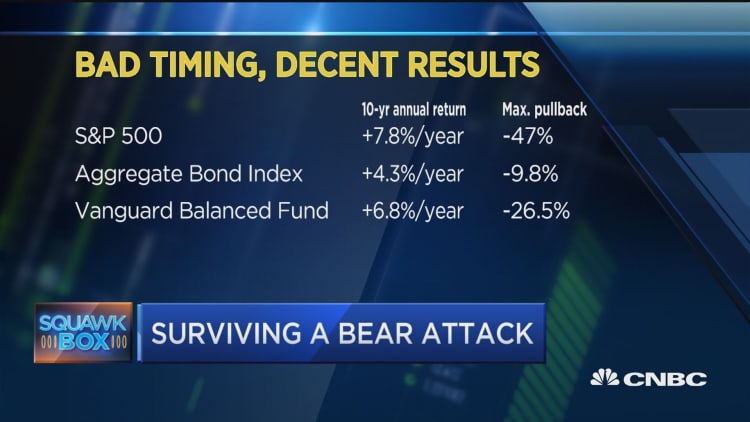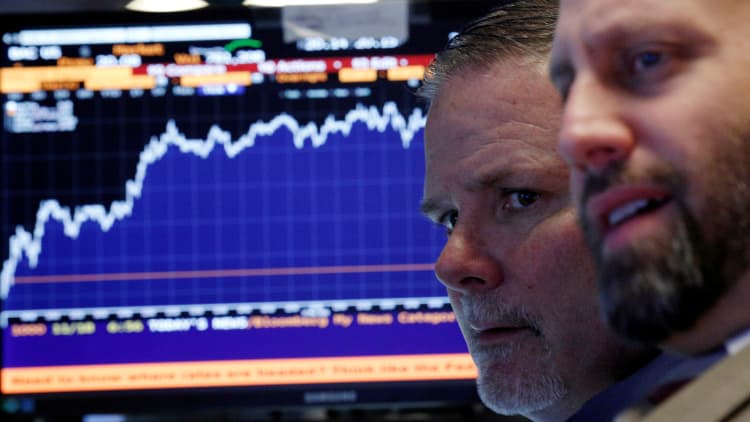
Investing in the stock market a decade ago today was, in retrospect, an awful way to treat your money.
That's when the global financial crisis began to erupt with the halting of withdrawals from some BNP Paribas funds, ushering in 18 months of wealth destruction and economic peril.
Perhaps surprisingly, though, that money put into stocks at such a bad time would have been treated reasonably well since then by the markets — for those who resisted the natural human flight instinct and held tight during a few scary years that followed.
In the 10 years since the crisis got rolling, the has returned 7.8 percent, annualized, including dividends. That's not far below the very long-term average yearly return of just under 10 percent. So a very unlucky investor who climbed into equities as they were about to careen off a cliff hasn't been hurt too badly.
If you invested Aug. 9, 2007, as the Global Financial Crisis began:
| | 10-year total return | Maximum pullback |
|---|---|---|
| S&P 500 | +7.8%/year | -47% |
| Aggregate Bond Index | +4.3%/year | -9.8% |
| Vanguard Balanced Fund | +6.8%/year | -26.5% |
Source: Source: FactSet
A standard portfolio mix of stocks and bonds, as reflected in the Vanguard Balanced Index Fund, has returned a decent 6.8 percent over the same span, with roughly half the downside volatility experienced by the S&P 500.
Clearly, the passage of time in the markets can help make up for bad timing. In this case, too, an investor has been aided by the most aggressive central bank support programs ever conceived, a long corporate profits boom and one of the longest bull markets in history, which has taken equity valuations to the upper end of their historical range.
See it as yet another bit of evidence supporting the virtues of patience in buying and holding stocks for the long term.
Yet the benefits of hindsight are not available in the moment, and this comforting retrospective makes it easy to overlook both how easy it was to be enticed into the market in August 2007, and how easy it would've been to bail out as things got ugly in the months and years that followed.
From today's perch, the ominous signs that would lead to the crisis and bear market might seem clear. Mortgage defaults were rising, a few aggressive subprime lenders had failed, Bear Stearns was forced to close some internal hedge funds, the Federal Reserve had ceased a multiyear rate hiking campaign because the economy looked a bit fragile.
In the summer of 2007, though, this all did not seem to be decisive threats to what was at that point a decent little bull market following the tech meltdown of 2000-2002. Stocks had been rising nicely for five years, gaining about 12 percent a year with dividends.
The market seemed reasonably valued, at just 15 times forecast earnings for the following year – about the same multiple as a few years earlier and well below the current 17.8 times. Investment pros frequently cited the lack of retail-investor participation as a reason that stocks had plenty of room to run higher.
On Aug. 9, 2007, the day the BNP fund closures sparked a swift stock sell-off, a CNN/Money market wrap-up concluded:
"Concerns about credit and the housing market aren't likely to disappear anytime soon…Yet, going forward, the equity market is probably in a better place to absorb the unrest than it was a month ago, since many of the stock indexes are well off their 2007 highs."
Even that December, two months after the market crested, Wall Street strategists as a group would still be predicting a 10 percent gain for the S&P 500 for 2008. Abby Joseph Cohen of Goldman Sachs that month said, "We expect the U.S. economy to show the strains of the deflating housing market and credit-market disruptions in early 2008. [But] recession likely will be avoided, due to strength in exports and capital spending by corporations and government."
As the financial contagion spread from subprime mortgages to the entire credit market and then to the real economy, stocks were liquidated, losing 20 percent from their peak and earning bear market status by mid-September of 2008. Good, long-term investors are trained to add market exposure on big downturns, right?
Well, buying the market at a 20 percent discount at that moment meant loading up right before Lehman Brothers failed, throwing the financial system into unprecedented disarray and driving an all-out liquidation of stocks.
By the time stocks would bottom in March 2009 with the Dow just under 7,000 — after a number of violent, fleeting rallies — the investor who got into stocks on Aug. 9, 2007, was down 47 percent and the conservative Vanguard Balanced fund was off 26 percent, in just 17 months. Pimco's revered bond fund chief Bill Gross was raising the prospect of the Dow falling all the way to 5,000 and the talk was of another Great Depression, or perhaps a lost generation for investors.
So, yes, it was tough to ignore the drama and stick to a long-term investing strategy. And perhaps it was almost as hard to stick it out and add to equities through the European debt crisis and debt ceiling standoff of 2011 and assorted recession scares and Fed-centered bouts of anxiety since. A buyer of the S&P 500 10 years ago had to wait 4½ years just to get back to even (including dividends), and the balanced-fund buyer spent more than two years under water.
(Ben Carlson of Ritholtz Wealth Management recently wrote a few years ago about a hypothetical "world's worst market timer," drawing some useful lessons from the exercise.)
At multiple points along the way up through 2010, the trailing 10-year return on U.S. stocks was negative, testing the nerve of investors raised to believe that the market is almost always a good bet.
The fact that time and an economic rebound and market revival have bailed out the ill-timed investments of August 2007 should be comforting, in this regard — while also acting as a reminder that fortune favors those with patience, a plan and a high pain threshold.
WATCH: Barney Frank: Reforms reduced chances of a stock market crash without hurting growth



